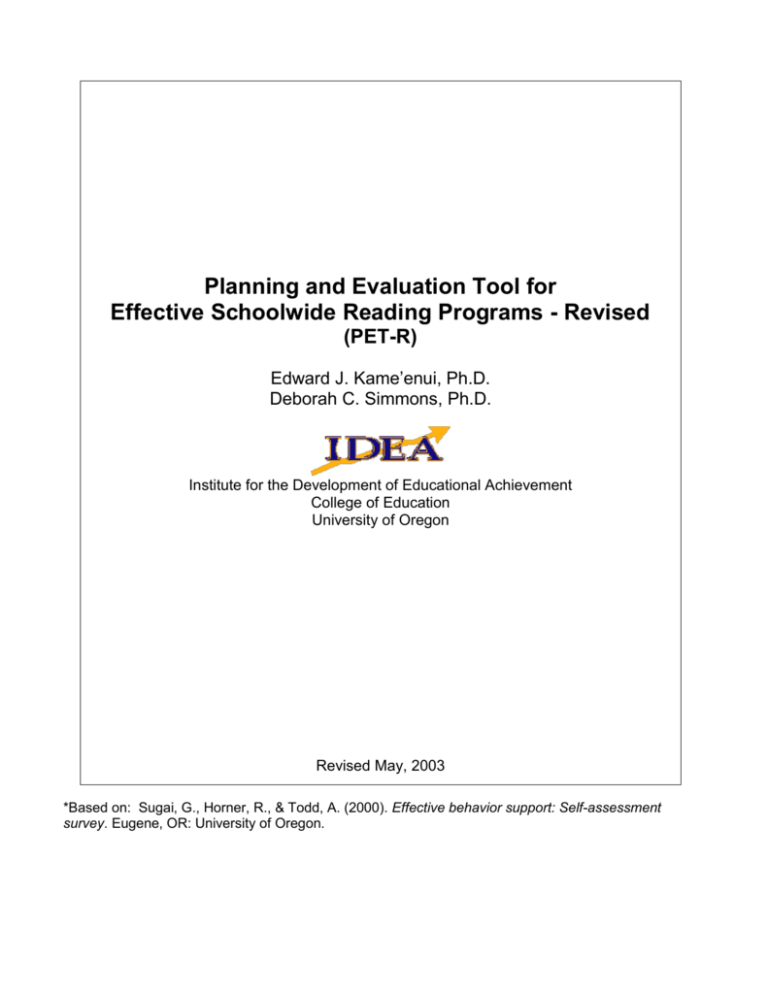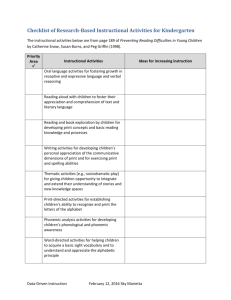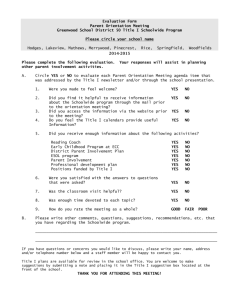Benchmarking Tool for Effective Schoolwide Reading Programs
advertisement

Planning and Evaluation Tool for Effective Schoolwide Reading Programs - Revised (PET-R) Edward J. Kame’enui, Ph.D. Deborah C. Simmons, Ph.D. Institute for the Development of Educational Achievement College of Education University of Oregon Revised May, 2003 *Based on: Sugai, G., Horner, R., & Todd, A. (2000). Effective behavior support: Self-assessment survey. Eugene, OR: University of Oregon. 2 Planning and Evaluation Tool for Effective Schoolwide Reading Programs - Revised School: Date: Position (check one): Current Grade(s) Taught (if applicable): Administrator Kindergarten Teacher First Paraprofessional/Educational Assistant Second Grade Level Team Third Years of Teaching Experience: Years at Present School: Directions Based on your knowledge of your school’s reading program (e.g., goals, materials, allocated time), please use the following evaluation criteria to rate your reading program’s implementation. Each item has a value of 0, 1, or 2 to indicate the level of implementation (see below). Please note that some items are designated with a factor, (e.g., x 2). Items with this designation are considered more important in the overall reading program. Multiply your rating by the number in parentheses and record that number in the blank to the left of the item. In the right-hand column of the table, document evidence available to support your rating for each item. Levels of Implementation Description 0 = Not in place 1 = Partially in place 2 = Fully in place 3 Planning and Evaluation Tool for Effective Schoolwide Reading Programs Internal/External Auditing Form 0 Not in place 1 Partially in place EVALUATION CRITERIA I. 2 Fully in place DOCUMENTATION OF EVIDENCE Goals, Objectives, Priorities – Goals for reading achievement are clearly defined, anchored to research, prioritized in terms of importance to student learning, commonly understood by users, and consistently employed as instructional guides by all teachers of reading. Goals and Objectives: 1. are clearly defined and quantifiable at each grade level. 2. are articulated across grade levels. 3. are prioritized and dedicated to the essential elements (i.e., phonemic awareness, phonics, fluency, vocabulary, and comprehension) in reading (x 2). 4. guide instructional and curricular decisions (e.g., time allocations, curriculum program adoptions) (x 2). 5. are commonly understood and consistently used by teachers and administrators within and between grades to evaluate and communicate student learning and improve practice. /14 Total Points 7 = 50% % Percent of Implementation: 11 = 80% 14 = 100% 4 0 Not in place 1 Partially in place EVALUATION CRITERIA 2 Fully in place DOCUMENTATION OF EVIDENCE II. Assessment – Instruments and procedures for assessing reading achievement are clearly specified, measure essential skills, provide reliable and valid information about student performance, and inform instruction in important, meaningful, and maintainable ways. Assessment: 1. A schoolwide assessment system and database are established and maintained for documenting student performance and monitoring progress (x 2). 2. Measures assess student performance on prioritized goals and objectives. 3. Measures are technically adequate (i.e., have high reliability and validity) as documented by research. 4. All users receive training and followup on measurement administration, scoring, and data interpretation. 5. At the beginning of the year, screening measures identify students' level of performance and are used to determine instructional needs. 6. Progress monitoring measures are administered formatively throughout the year to document and monitor student reading performance (i.e., quarterly for all students; every 4 weeks for students at risk). 5 II. Assessment continued EVALUATION CRITERIA DOCUMENTATION OF EVIDENCE 7. Student performance data are analyzed and summarized in meaningful formats and routinely used by grade-level teams to evaluate and adjust instruction (x 2). 8. The building has a “resident” expert or experts to maintain the assessment system and ensure measures are collected reliably, data are scored and entered accurately, and feedback is provided in a timely fashion. /20 Total Points % Percent of Implementation: 10 = 50% 16 = 80% 20 = 100% 6 0 Not in place 1 Partially in place EVALUATION CRITERIA 2 Fully in place DOCUMENTATION OF EVIDENCE III. Instructional Programs and Materials - The instructional programs and materials have documented efficacy, are drawn from research-based findings and practices, align with state standards and benchmarks, and support the full range of learners. 1. A comprehensive or core reading program with documented research-based efficacy is adopted for use school wide (x 3). 2. The instructional program and materials provide explicit and systematic instruction on critical reading priorities (i.e., phonemic awareness, phonics, fluency, vocabulary, and comprehension) (x 2). 3. The instructional materials and program align with and support state standards/scientifically based practices and provide sufficient instruction in essential elements to allow the majority of students to reach learning goals. 4. Supplemental and intervention programs of documented efficacy are in place to support students who do not benefit adequately from the core program (x 2). 5. Programs and materials are implemented with a high level of fidelity (x 3). /22 Total Points % Percent of Implementation: 11 = 50% 18 = 80% 22 = 100% 7 0 Not in place 1 Partially in place EVALUATION CRITERIA 2 Fully in place DOCUMENTATION OF EVIDENCE IV. Instructional Time - A sufficient amount of time is allocated for instruction and the time allocated is used effectively. 1. A schoolwide plan is established to allocate sufficient reading time and coordinate resources to ensure optimal use of time. 2. Reading time is prioritized and protected from interruption (x 2). 3. Instructional time is allocated to skills and practices most highly correlated with reading success (i.e., essential elements of reading including phonemic awareness, phonics, fluency, vocabulary, and comprehension). 4. Students in grades K-3 receive a minimum of 30 minutes of small-group teacher-directed reading instruction daily (x 2). 5. Additional instructional time is allocated to students who fail to make adequate reading progress. /14 Total Points 7 = 50% % Percent of Implementation: 11 = 80% 14 = 100% 8 0 Not in place 1 Partially in place EVALUATION CRITERIA 2 Fully in place DOCUMENTATION OF EVIDENCE V. Differentiated Instruction/Grouping/Scheduling - Instruction optimizes learning for all students by tailoring instruction to meet current levels of knowledge and prerequisite skills and organizing instruction to enhance student learning. 1. Student performance is used to determine the level of instructional materials and to select research-based instructional programs. 2. Instruction is provided in flexible homogeneous groups to maximize student performance and opportunities to respond. 3. For children who require additional and substantial instructional support, tutoring (1-1) or small group instruction (< 6) is used to support teacher-directed large group or whole class instruction. 4. Group size, instructional time, and instructional programs are determined by and adjusted according to learner performance (i.e., students with greatest needs are in groups that allow more frequent monitoring and opportunities to respond and receive feedback). 5. Cross-class and cross-grade grouping is used when appropriate to maximize learning opportunities. /10 Total Points 5 = 50% % Percent of Implementation: 8 = 80% 10 = 100% 9 0 Not in place 1 Partially in place EVALUATION CRITERIA 2 Fully in place DOCUMENTATION OF EVIDENCE VI. Administration/Organization/Communication - Strong instructional leadership maintains a focus on high-quality instruction, organizes and allocates resources to support reading, and establishes mechanisms to communicate reading progress and practices. 1. Administrators or the leadership team are knowledgeable of state standards, priority reading skills and strategies, assessment measures and practices, and instructional programs and materials. 2. Administrators or the leadership team work with staff to create a coherent plan for reading instruction and implement practices to attain school reading goals. 3. Administrators or the leadership team maximize and protect instructional time and organize resources and personnel to support reading instruction, practice, and assessment. 4. Grade-level teams are established and supported to analyze reading performance and plan instruction. 5. Concurrent instruction (e.g., Title, special education) is coordinated with and complementary to general education reading instruction. 6. A communication plan for reporting and sharing student performance with teachers, parents, and school, district, and state administrators is in place. /12 Total Points 6 = 50% % Percent of Implementation: 10 = 80% 12 = 100% 10 0 Not in place 1 Partially in place EVALUATION CRITERIA 2 Fully in place DOCUMENTATION OF EVIDENCE VII. Professional Development - Adequate and ongoing professional development is determined and available to support reading instruction. 1. Teachers and instructional staff have thorough understanding and working knowledge of grade-level instructional/reading priorities and effective practices. 2. Ongoing professional development is established to support teachers and instructional staff in the assessment and instruction of reading priorities. 3. Time is systematically allocated for educators to analyze, plan, and refine instruction. 4. Professional development efforts are explicitly linked to practices and programs that have been shown to be effective through documented research. /8 Total Points 4 = 50% % Percent of Implementation: 6.5 = 80% 8 = 100% 11 Planning and Evaluation Tool for Effective Schoolwide Reading Programs Individual Summary Score Directions: Return to each element (e.g., goals; assessment) and total the scores at the bottom of the respective page. Transfer each element's number to the designated space below. Sum the total scores to compute your overall evaluation of the schoolwide reading program. The total possible value is 100 points. The total score can be used to evaluate the overall quality of the school's reading program. Evaluate each element to determine the respective quality of implementation. For example, a score of 11 in Goals/Objectives/Priorities means that in your estimation the school is implementing approximately 80% of the items in that element. Element Score I. Goals/Objectives/Priorities /14 II. Assessment /20 III. Instructional Practices and Materials /22 IV. Instructional Time /14 V. Differentiated Instruction/Grouping /10 VI. Administration/Organization/Communication /12 VII. Professional Development Total Score /8 /100 Percent 12 Planning and Evaluation Tool for Effective Schoolwide Reading Programs School Summary Score Calculating Average Schoolwide Element Scores: Enter each individual's score by element on the following table. Sum down each column and divide by the number of participants to achieve an average school score for each element. Calculate the proportion of total points for each element by dividing the average element score by the total possible points. This will provide the percentage of total points earned for each element. Calculating Average Schoolwide Overall Scores. Enter the total scores of each individual in the designated space. Sum across the Total row and divide by the number of participants to achieve an average overall score for the school. 13 Planning and Evaluation Tool for Effective Schoolwide Reading Programs Average Schoolwide Overall Scores Name Goals Assessment Instr. Prac. Instr. Time Grouping Admin. Prof. Dev. I II III IV V VI VII 14 20 22 14 10 12 8 1 2 3 4 5 6 7 8 9 10 11 12 13 14 15 16 17 18 19 20 Total Mean Points Possible Percentage of Total Points 14 Planning and Evaluation Tool for Effective Schoolwide Reading Programs Narrative Summary 1. Based on the schoolwide summary scores for each element and the average total schoolwide score, identify the areas of strength. Strengths may be based on elements or on specific items within elements. 2. List each element and specific items within each element that are in need of further development. 15 Institute on Beginning (IBR) Reading Action Plan (RAP) Name of School, District City, State Reading Goals and Priorities 1. What: Who: When: 2. What: Who: When: 3. What: Who: When: Committee Members Adopted by School Staff on: Date






